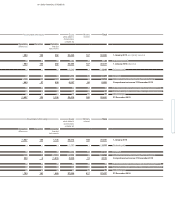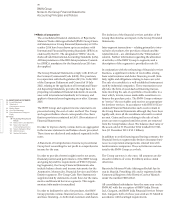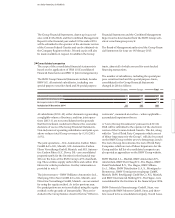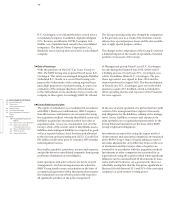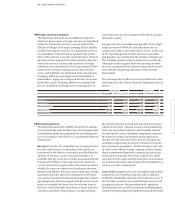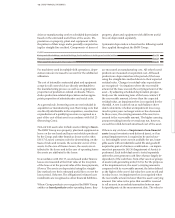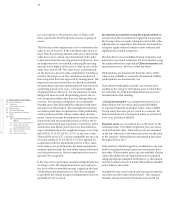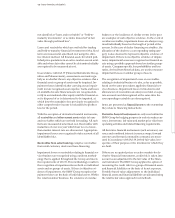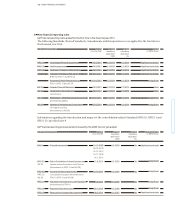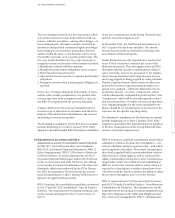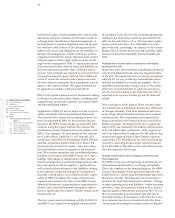BMW 2014 Annual Report Download - page 106
Download and view the complete annual report
Please find page 106 of the 2014 BMW annual report below. You can navigate through the pages in the report by either clicking on the pages listed below, or by using the keyword search tool below to find specific information within the annual report.
106
90 GROUP FINANCIAL STATEMENTS
90 Income Statements
90 Statement of
Comprehensive Income
92 Balance Sheets
94 Cash Flow Statements
96 Group Statement of Changes in
Equity
98 Notes
98 Accounting Principles and
Policies
116 Notes to the Income Statement
123 Notes to the Statement
of Comprehensive Income
124
Notes to the Balance Sheet
149 Other Disclosures
165 Segment Information
Derivative financial instruments are measured using
market information and recognised valuation tech-
niques. In those cases where hedge accounting is ap-
plied, changes in fair value are recognised either in
profit or loss or in other comprehensive income as a
component of accumulated other equity, depending
on whether the transactions are classified as fair value
hedges or cash flow hedges. In the case of fair value
hedges, the results of the fair value measurement of
the
derivative financial instruments and the related
hedged items are recognised in the income statement.
In the case of fair value changes in cash flow hedges
which are used to mitigate the future cash flow risk
on
a recognised asset or liability or on forecast trans-
actions, unrealised gains and losses on the hedging
instrument are recognised initially directly in accumu-
lated other equity. Any such gains or losses are recog-
nised subsequently in the income statement when the
hedged item (usually external revenue) is recognised
in the income statement. The portion of the gains or
losses from fair value measurement not relating to the
hedged item is recognised immediately in the income
statement. If, contrary to the normal case within the
BMW Group, hedge accounting cannot be applied, the
gains or losses from the fair value measurement of
derivative financial instruments are recognised imme-
diately in the income statement.
In accordance with IAS 12 (Income Taxes), deferred taxes
are recognised on all temporary differences between
the tax and accounting bases of assets and liabilities and
on consolidation procedures. Deferred tax assets also
include claims to future tax reductions which arise from
the expected usage of existing tax losses available for
carryforward to the extent that future usage is probable.
Deferred taxes are computed using enacted or planned
tax rates which are expected to apply in the relevant
national jurisdictions when the amounts are recovered.
Inventories of raw materials, supplies and goods for re-
sale are stated at the lower of average acquisition cost
and net realisable value.
Work in progress and finished goods are stated at the
lower of average manufacturing cost and net realisable
value. Manufacturing cost comprises all costs which
are directly attributable to the manufacturing process
and an appropriate proportion of production-related
overheads. This includes production-related
deprecia-
tion and an appropriate proportion of administrative and
social costs.
Borrowing costs are not included in the acquisition or
manufacturing cost of inventories.
Cash and cash equivalents comprise mainly cash on hand
and cash at bank with an original term of up to three
months.
Assets held for sale and disposal groups held for sale
are presented separately in the balance sheet in ac-
cordance with IFRS 5, if the carrying amount of the
relevant assets will be recovered principally through a
sale transaction rather than through continuing use.
This situation only arises if the assets can be sold imme-
diately in their present condition, the sale is expected
to be completed within one year from the date of classi-
fication and the sale is highly probable. At the date of
classification, property, plant and equipment, intangible
assets and disposal groups which are being held for
sale
are measured at the lower of their carrying amount
and their fair value less costs to sell and scheduled de-
preciation / amortisation ceases. This does not apply,
however, to items within the disposal group which are
not covered by the measurement rules contained in
IFRS 5. Simultaneously, liabilities directly related to the
sale are presented separately on the equity and
liabili-
ties side of the balance sheet as “Liabilities in conjunction
with assets held for sale”.
Provisions for pensions are recognised using the pro-
jected
unit credit method in accordance with IAS 19
(Employee Benefits). Under this method, not only
obli-
gations relating to known vested benefits at the re-
porting
date are recognised, but also the effect of future
increases in pensions and salaries. This involves taking
account of various input factors which are evaluated
on a prudent basis. The calculation is based on an inde-
pendent actuarial valuation which takes into account
all relevant biometric factors.



